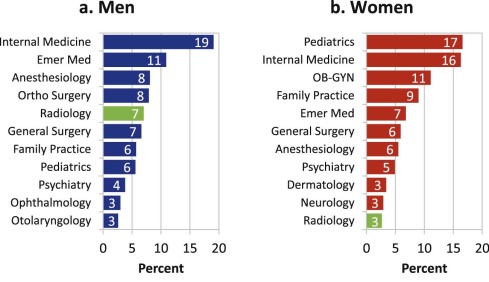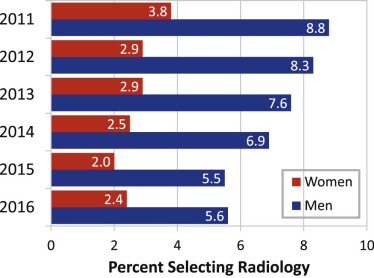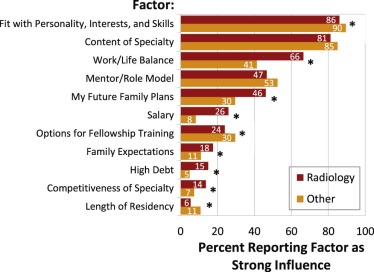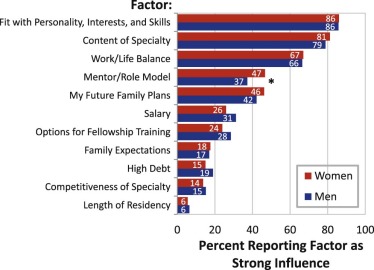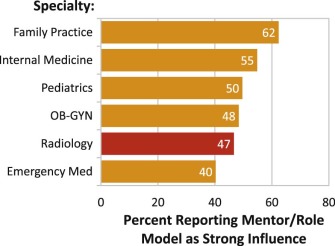Rationale and Objectives
Women continue to be under represented in diagnostic radiology. According to the Association of American Medical College’s 2016 Physician Specialty Data Report, women made up only 25% of the field of diagnostic radiology in 2015. Our investigation centered on determining how factors influencing specialty choices differ for female medical students planning to pursue a residency in radiology versus other specialties. We also examined gender differences for male and female students choosing radiology.
Materials and Methods
Using deidentified 2011–2016 Graduation Questionnaire data from the Association of American Medical College’s national survey of fourth-year medical students, we analyzed cross-sectional data from 71,941 respondents on career intentions, including factors influencing their choice of specialty such as mentor, salary, debt, family considerations, and fit with interests/skills. The 10 most common specialty choices were reported by gender. Women choosing radiology were compared to women choosing other specialties in terms of factors influencing choice of specialty. Women were also compared to men choosing radiology.
Results
Whereas 48% of all fourth-year medical students were women, only 26% of fourth-year medical students selecting radiology as a specialty were women. Radiology ranked fifth for men as the most common specialty choice, but 11th for women. Work/life balance, future family plans, salary, family expectations, high debt, and competitiveness of specialty were strong influencing factors for a significantly higher proportion of women selecting radiology than women selecting other specialties, but length of residency was a factor for a higher proportion of women in other specialties. Of students selecting radiology, a higher proportion of women than men said mentors were a strong factor (47% vs 37%).
Conclusion
To reduce the gender disparity in radiology, active engagement of mentors in the profession should be a priority in radiology departments. Other factors such as promoting radiology as an intellectual specialty with strong positive attributes such as work/life balance and salary should be highlighted as well.
Introduction
As with other specialties in medicine, the majority of physicians within the field of radiology are male. Study results of radiology workforce in 2014 showed that 22% were women, and 78% were men. This was in contrast to 18% women and 82% men who made up the radiology workforce from a survey in 2003 ( ).
Over the past few decades, the number of women entering the field of medicine has been increasing. In 2016, the number of females entering medical school was at a 10-year high, increasing by 6.2% from 2015.
Get Radiology Tree app to read full this article<
Get Radiology Tree app to read full this article<
Get Radiology Tree app to read full this article<
Methods
Study Cohort
Get Radiology Tree app to read full this article<
Get Radiology Tree app to read full this article<
Variables
Get Radiology Tree app to read full this article<
Table 1
Influencing Factors for Specialty Choice
How influential were the following in helping you choose your specialty? • Competitiveness of specialty • Family expectations • High level of educational debt • My future family plans • Mentor/role model influence • Work/life balance • Options for fellowship training • Fit with personality, interests and skills • Salary expectations • Content of specialty • Length of residency training
Note : Responses were no (0), minor (1), moderate (2), or strong (3) influence.
Get Radiology Tree app to read full this article<
Get Radiology Tree app to read full this article<
Statistical Analysis
Get Radiology Tree app to read full this article<
Results
Get Radiology Tree app to read full this article<
Table 2
Demographics of Fourth-Year Medical School Students Taking GQ From 2011 to 2016 Overall and for Group Selecting Radiology as a Specialty Choice
Total Radiology Male ( n = 37,380) Female ( n = 34,561) Male ( n = 2601) Female ( n = 915) Race/ethnicity, %Hispanic 7.0 7.6 5.5 5.9Non-Hispanic White 66.0 59.3 62.2 53.3Non-Hispanic Black 3.1 6.5 2.2 4.2Non-Hispanic Asian 17.7 19.7 23.5 28.9Non-Hispanic Mixed 3.2 3.9 3.5 3.7Non-Hispanic Other \* 2.9 3.0 3.3 4.0
Get Radiology Tree app to read full this article<
Get Radiology Tree app to read full this article<
Get Radiology Tree app to read full this article<
Get Radiology Tree app to read full this article<
Get Radiology Tree app to read full this article<
Get Radiology Tree app to read full this article<
Get Radiology Tree app to read full this article<
Get Radiology Tree app to read full this article<
Get Radiology Tree app to read full this article<
Get Radiology Tree app to read full this article<
Discussion
Get Radiology Tree app to read full this article<
Get Radiology Tree app to read full this article<
Get Radiology Tree app to read full this article<
Get Radiology Tree app to read full this article<
Get Radiology Tree app to read full this article<
Get Radiology Tree app to read full this article<
Get Radiology Tree app to read full this article<
Get Radiology Tree app to read full this article<
Get Radiology Tree app to read full this article<
Get Radiology Tree app to read full this article<
Conclusion
Get Radiology Tree app to read full this article<
References
1. Bluth E.I., Bansal S., Macura K.J., Fielding J., Truong H.: Gender and the radiology workforce: results of the 2014 ACR workforce survey. J Am Coll Radiol 2015; 12: pp. 155-157.
2. Lewis R.S., Bhargavan M, Sunshine J.H.: Women radiologists in the United States: results from the American College of Radiology’s 2003 survey. Radiology 2007; 242: pp. 802-810.
3. Rose S.H., Long T.R.: Accreditation council for graduate medical education (ACGME) annual anesthesiology residency and fellowship program review: a “report card” model for continuous improvement. BMC Med Educ 2010; 10: pp. 13.
4. Grayson M.S., et. al.: Impact of AOA status and perceived lifestyle on career choices of medical school graduates. J Gen Intern Med 2011; 26: pp. 1434-1440.
5. https://www.aamc.org/download/359156/data/radiology-diagnostic.pdf .
6. https://www.aamc.org/download/464412/data/2016gqallschoolssummaryreport.pdf .
7. Fielding J.R., et. al.: Choosing a specialty in medicine: female medical students and radiology. Am J Roentgenol 2007; 188: pp. 897-900.
8. Arleo E.K., et. al.: Surveying fourth-year medical students regarding the choice of diagnostic radiology as a specialty. J Am Coll Radiol 2016; 13: pp. 188-195.
9. Campbell J.C., Yoon S.C., Cater S.W., Grimm L.J.: Factors influencing the gender breakdown of academic radiology residency programs. J Am Coll Radiol 2017; 14: pp. 958-962.
10. Zener R., et. al.: Women in radiology: exploring the gender disparity. J Am Coll Radiol 2016; 13: pp. 344-350.
11. Buddeberg-Fischer B., et. al.: Specialising in radiology in Switzerland: still attractive for medical school graduates?. Eur J Radiol 2012; 81: pp. 1644-1651.
12. Harris J.E., Løpez-Valcárcel B.G., Ortún V., Barber P.: Specialty choice in times of economic crisis: a cross-sectional survey of Spanish medical students. BMJ Open 2013; 3: e002051
13. Deitch C.H., Sunshine J.H., Chan W.C., Shaffer K.A.: Women in the radiology profession: data from a 1995 national survey. AJR. Am J Roentgenol 1998; 170: pp. 263-270.
14. Kostrubiak D.E., et. al.: Mentorship in Radiology. Curr Probl Diagn Radiol 2017; 46: pp. 385-390.
15. Neumayer L., et. al.: Perceptions of women medical students and their influence on career choice. Am J Surg 2002; 183: pp. 146-150.
16. McMurray J.E., Schwartz M.D., Genero N.P., Linzer M.: The attractiveness of internal medicine: a qualitative analysis of the experiences of female and male medical students. Ann Intern Med 1993; 119: pp. 812-818.
17. Roubidoux M.A., Packer M.M., Applegate K.E., Aben G.: Female medical students’ interest in radiology careers. J Am Coll Radiol 2009; 6: pp. 246-253.
18. Ladd L.M., et. al.: A mentorship and networking group for women in radiology. J Am Coll Radiol 2017; 14: pp. 987-990.
19. Amorosa J.K.: How do I mentor medical students interested in radiology?. Acad Radiol 2004; 11: pp. 91-95.
20. Lee J.M., Anzai Y., Langlotz C.P.: Mentoring the mentors: aligning mentor and mentee expectations. Acad Radiol 2006; 13: pp. 556-561.
21. Applegate K.E.: The future workforce in academic radiology: gender, generational, and cultural influences. J Am Coll Radiol 2005; 2: pp. 133-138.
22. Branstetter B.F., Faix L.E., Humphrey A.L., Schumann J.B.: Preclinical medical student training in radiology: the effect of early exposure. Am J Roentgenol 2007; 188: pp. W9-W14.
23. Surawicz C.M.: Women in leadership: why so few and what to do about it. J Am Coll Radiol 2016; 13: pp. 1433-1437.
24. Gunderman R.B., et. al.: The value of good medical student teaching increasing the number of radiology residency applicants. Acad Radiol 2000; 7: pp. 960-964.
25. Grimm L.J., Lowell D.A., Cater S.W., Yoon S.C.: Differential motivations for pursuing diagnostic radiology by gender: implications for residency recruitment. Acad Radiol 2017; 24: pp. 1312-1317. Chicago
26. Francavilla M.L., et. al.: Surveying academic radiology department chairs regarding new and effective strategies for medical student recruitment. Am J Roentgenol 2016; 207: pp. 1171-1175.
27. Hawkins C.M., Duszak R., Rawson J.V.: Social media in radiology: early trends in Twitter microblogging at radiology’s largest international meeting. J Am Coll Radiol 2014; 11: pp. 387-390.
28. Retrouvey M., et. al.: Women in radiology: creating a global mentorship network through social media. J Am Coll Radiol 2017; 15: pp. 229-232.
29. Heitkamp D.E., Norris C.D., Rissing S.M.: The illusion of choice: gender segregation and the challenge of recruiting women to radiology. J Am Coll Radiol 2017; 14: pp. 991-994.
